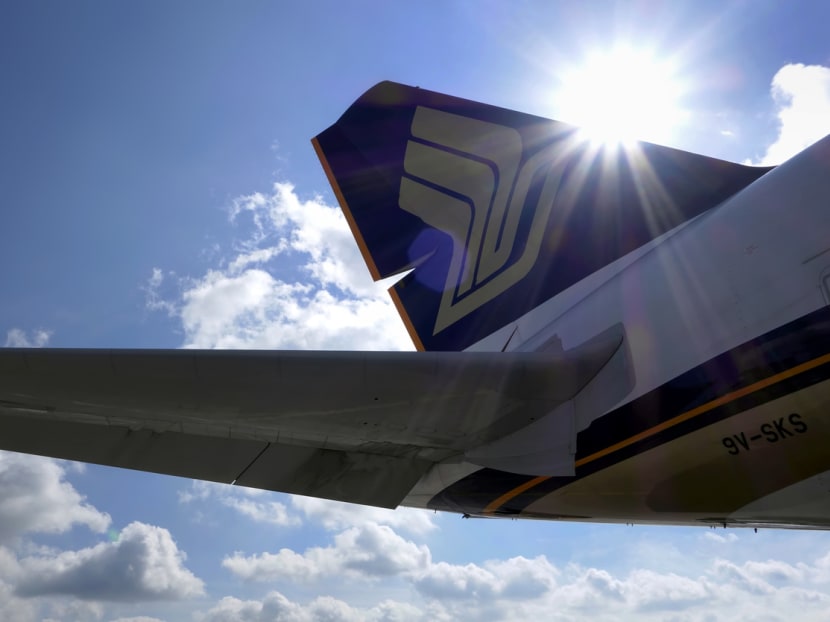As the world reopens, is it time for Singapore's travel stocks to shine?

File photo of a Singapore Airlines plane. (Photo: iStock/olyniteowl)
SINGAPORE: The world is reopening after more than two years of COVID-19 and battered travel-related stocks are finally getting a lift from the return of travellers.
Here, aviation and hospitality stocks on the Straits Times Index have rebounded from the lows hit during the depths of the pandemic, after Singapore reopened its borders. With more countries easing travel curbs, the worst is likely over, said market analysts.
Yet, the coast is not all clear.
Uncertainties over the COVID-19 pandemic linger amid the emergence of new strains. Rising costs, from crude oil, food to manpower, the threats of faster-than-expected monetary policy tightening and a global recession could also derail any recovery, the analysts told CNA.
“If you end up in a recession or significantly slowing growth where inflation still persists, you’re not going to see travellers as people are going to cut down on spending and will want to be saving up as much as they can,” said Mr Shekhar Jaiswal, head of equity research at RHB Singapore.
“Then suddenly, all of the tailwinds for your top line will disappear.”
“WAIT AND SEE”
For Singapore Airlines (SIA), the national carrier is looking set for a turnaround as it narrowed losses in the financial year that just ended. Analysts expect the airline to return to profitability on an annual basis this year.
According to a Bloomberg poll of analysts, SIA should be able to generate about S$160 million in net profit for financial year (FY) 2023. Some are more bullish, such as DBS Group Research which is projecting a net profit of S$500 million on the back of expectations that passenger volumes will normalise faster than initially thought and yields on both passenger and cargo fronts to be high.
But even as the airline mends its bruised financials, turbulence remains on the horizon.
The biggest downside risk comes from surging oil prices, said CGS-CIMB analyst Raymond Yap in a report dated May 26, noting how SIA has only hedged 40 per cent of its fuel requirements at an average Brent strike price of US$60 per barrel up to June next year.
Staff costs pose another challenge, as SIA looks to reverse salary cuts and rebuild its workforce at a time of rising wage expectations and tapering government subsidies, said Mr Jaiswal.
There also remain doubts about the return of travel in the longer run, particularly the business segment which is a key source of revenue for airlines, he added.
These mean that the airline’s shares, which have climbed about 4 per cent this year but remain about 18 per cent below their pre-pandemic levels, may face limited runway ahead.
CGS-CIMB noted that with the stock having run up about 60 per cent from its 2020 lows, its recent downgrade to a “hold” call is “appropriate as the stock’s risk and reward appear balanced at this stage”.
Morgan Stanley equity analysts said in a May 18 report that while SIA is “a good reopening play”, the counter’s rich valuations and historical averages already reflect positive developments, thereby limiting further upside.
Likewise for SIA Engineering and SATS, there remain challenges that could weigh on profitability.
“We believe the worst looks to be over for these two companies but they are not completely out of the woods yet as the COVID-19 virus continues to evolve,” said Mr Terence Chua, senior research analyst at Phillip Securities Research.
Both firms also face the issue of higher staff costs as they ramp up hiring to meet recovery needs. This will weigh on their bottom lines in the near term, he added.
Government wage support has played a huge role in shoring up the financials of both listed companies, going by their latest full-year results.
SIA Engineering reported a full-year net profit of S$67.6 million for FY2022, a reversal from a loss of S$11.2 million in the year-ago period. But this turnaround “is still largely on paper”, noted DBS analysts, as it includes wage support grants and substantial associate and joint venture contributions.
Similarly for SATS, the group’s net profit attributable to shareholders would have been a loss of S$112.2 million if government reliefs were excluded for FY2022, instead of a net profit of S$20.4 million.
The ground handler also faces the additional challenge of rising food costs, which it might have difficulties passing on to its customers, said a DBS report. Taken together with manpower, the firm’s operating costs will likely outpace revenue growth over the next few quarters, it added.
Asked about the outlook of the companies’ shares, Mr Chua said upside momentum is “capped in the near term” with the recovery already priced in.
Both counters have rallied on the back of easing border controls in recent months – up more than 12 per cent for SIA Engineering and 3 per cent for SATS year to date.
Analysts from DBS agreed that current share prices have “factored in the reopening story” and could “take a breather”, as they downgraded to “hold” for both SIA Engineering and SATS.
Summing up, Mr Jaiswal said investors of these aviation stocks will have to “wait and see” for improvements in earnings and the macro environment.
“Nobody’s questioning the revival in global aviation traffic. Nobody’s also questioning the fact that tourists are coming back to Singapore but the question now is, can (companies) ensure that cost increments will be the same proportions as revenue growth so that margins will not be compressed?
“For share prices to move up beyond the current range, we need significant news on the earnings and more clarity on the outlook,” he said.
HOSPITALITY STILL “ON THE TABLE”
On the other hand, analysts seem slightly more upbeat about the outlook of the hospitality sector.
RHB Singapore, for instance, has Genting Singapore as one of its preferred stock picks for the year ahead. Apart from the reopening of Singapore’s borders to those fully vaccinated, the easing of travel curbs by more countries will likely continue and boost the integrated resort operator’s recovery, it said.
To be sure, the recovery may still be missing a “last leg of runway” as strict travel measures remain in key markets in North Asia, namely China and Japan that accounted for one-third of pre-pandemic footfalls in both gaming and non-gaming facilities, said CGS-CIMB analyst Tay Wee Kuang in a report.
Nevertheless, Singapore’s easing of domestic rules to allow for larger work-related events of up to 1,000 people to be held means that more business activities can now resume, he added, while reiterating an “add” call on the stock and noting that a “recovery to pre-COVID operations remains on the table” albeit at a slower pace.
Beyond that, business trusts that have hotels in their portfolios are also in the good books of some market analysts.
Apart from seeing better occupancy levels and room rates as travel demand picks up, the likes of Ascott Residence Trust and CDL Hospitality Trusts have also delved into the “extended-stay” asset class over the course of the pandemic as part of diversifying their portfolios, Phillip Securities Research’s Natalie Ong told CNA.
“They haven't been idling. Instead, they have been trying to strengthen their portfolio by incorporating other streams of stable income,” said the research analyst, adding that most hospitality trusts are still trading at about 15 to 20 per cent below pre-pandemic levels.
Opportunities also exist in other parts of the Singapore market, analysts said although they recommend investors to stay defensive amid rising inflation and a confluence of external growth risks.
“We expect the market to remain volatile with increased external risks,” said CGS-CIMB analysts in their Singapore strategy report. “We advocate a near-term defensive position in REITs (real estate investment trusts) and high dividend yield stocks and remain constructive on capital goods.”
Technology and banking sectors have also “reverted to mean valuations and priced in some of the slower growth expectations”, hence presenting long-term opportunities, they added.
RHB, in a report dated Jun 1, reiterated its “barbell portfolio strategy, with a healthy weightage for defensive stocks”.
“Defensive meaning when things go south, the company still makes money and that cash flow does not completely disappear,” said Mr Jaiswal.
These include banks that are beneficiaries of the current rising interest rate environment, companies that are less affected by inflationary pressures such as the commodity sector, as well as those that can continue to deliver margin expansion such as homegrown telco Singtel or taxi operator ComfortDelGro.
Morgan Stanley’s equity analysts Wilson Ng and Derek Chang said Singapore banks are “especially well-positioned” to weather cost inflation headwinds and provide sustained growth in earnings and dividends, given how they are “positively levered to both rising interest rates and the reopening theme”.
“Valuation multiples do not look overstretched, so we believe banks may be more viable alternatives to stocks in the real estate and travel-related sectors as a shelter against high inflation,” they wrote in a May 12 report.
Apart from banks, Mr Ng and Mr Chang also like energy stocks while technology stocks can “offer a secular growth story at much more attractive valuations than before”.









